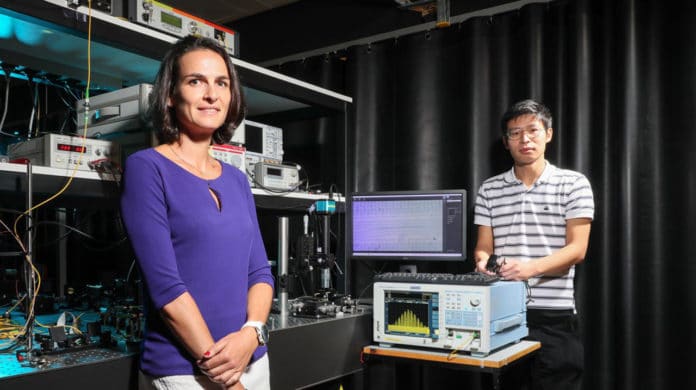Photonics comes in particularly useful in communications systems, the Internet of Things, and beamforming, a signal processing method used in antenna systems. But for the moment, microwave photonic systems still can’t generate light pulses on computer chips.
Thanks to scientists from EPFL‘s Photonics Systems Lab, it is possible to reconfigure microwave photonic filters without any external device.
Scientists have developed reconfigurable radiofrequency filters that can produce high-quality microwaves without a bulky external device. By creating interference between two pulses within a microcomb, they were able to control the pulses to reconfigure the outgoing radiofrequency accurately.
A microwave photonic filter converts an incoming radiofrequency into an optical signal that a photonic device can then prepare to extract information. A photoreceptor then converts the signal back into a radiofrequency.
In April, scientists in another EPFL laboratory, the K-Lab, generated different micro combs on a silicon nitride chip to produce high-quality soliton pulse signals. All that was left was to demonstrate that the pulse signals could be used to reconfigure the microwaves and that the system was just as flexible, linear, spectrally pure, and noise-free as the previous, more bulky devices – precisely what the researchers in the Photonics Systems Lab optimized the chip to do.
The technology used in these chips, which are smaller than a coin, is based on how light interacts with the surrounding environment. The signal’s wavelength can be modified by either varying the light source or changing the optical channel’s shape or material.
Camille Brès, who runs the Photonics Systems Lab, said, “Using a light source that can combine several wavelengths means that we can keep the filter’s structure quite simple. If we can reconfigure the frequency by altering the light pulse, we don’t need to change the physical support.”
Scientists could replace the laptop-sized light generators with miniature on-chip optical resonators that use laser pulses to generate perfect solitons.
Jianqi Hu, a Ph.D. student in the Photonics Systems Lab and the study’s lead author, said, “Current filters require programmable pulse shapes to set the outgoing frequency and improve the wave quality, which makes the systems complex and hard to market. To overcome this obstacle, the researchers generated on-chip interference between two solitons – by modifying the angle between them, they could reconfigure the filter frequency. This breakthrough means that these systems can be made fully portable and used with 5G and terahertz waves.”
Journal Reference:
- Hu, J., He, J., Liu, J. et al. Reconfigurable radiofrequency filters based on versatile soliton microcombs. Nat Commun 11, 4377 (2020). DOI: 10.1038/s41467-020-18215-z
